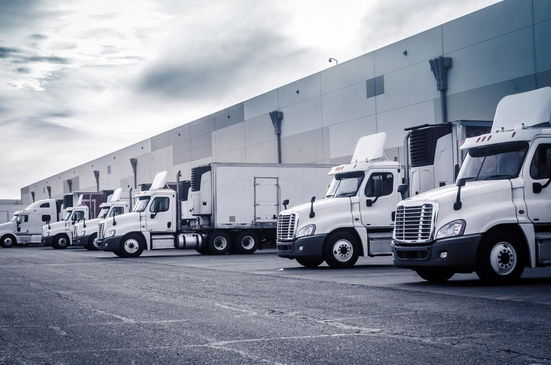Trucking is a massively cyclical industry.
How is it possible to have a “driver shortage” and a capacity glut at the same time?
This is a common refrain that I hear when talking about a slowing freight market. The reality is that the “driver shortage” doesn’t mean what most people think it means.
First, we need to differentiate between the freight market and trucking companies. Trucking companies participate in the freight market, but are not the “market.”

What is the freight market?
The freight market is not a specific place, but rather a collection of buyers and sellers of freight capacity. Buyers of capacity are usually shippers and sellers are usually carriers. But there are also a substantial number of intermediaries who play both sides of the market, known as “freight brokers.”
Shippers are companies that buy freight services to move their goods from one location to another. It could be a store brand that purchases the capacity to move freight from a warehouse to a store, but could also be a manufacturer that is shipping goods to a distribution center. There are countless reasons why a shipper buys trucking capacity.
Examples of shippers include big-box retailers (Walmart, Lowes, Tractor Supply, Best Buy and Target); consumer packaged goods companies (Nestle, Unilever and Procter & Gamble); auto manufacturers (Tesla, Ford and GM); chemical companies, lumber suppliers, etc.
Carriers are trucking companies that provide trucking services and are paid to move a load from one location to another. In the for-hire trucking industry, carriers can either be fleets (an owner owns more than one truck), or an owner-operator (the truck driver is often the owner of the truck).
Freight brokers play the role of intermediaries. They help find loads for carriers, but also provide shippers with capacity. A broker plays the role of both buyer and seller of capacity, but only as an intermediary, working on behalf of a third party. A freight broker sells capacity to a shipper and then buys capacity from a carrier.
When capacity is purchased through a broker, the shipper often doesn’t know which carrier is being contracted to haul the load. Likewise, the carrier that is contracted to haul the load often doesn’t know which shipper has purchased the capacity.
While only approximately 20% of all trucking freight is contracted through a broker, brokers play an important role in matching carriers with loads and shippers with capacity.
In the freight market, buyers of capacity compete with each other for that capacity and sellers compete with each other for loads. Rates will move up and down based on capacity conditions in the marketplace.
The total amount of dispatchable capacity is the only factor that determines the trucking market rate environment. If there is too little capacity, rates rise. If there is too much capacity, rates fall.

Dispatchable capacity
What is dispatchable capacity?
Dispatchable capacity is capacity that is available on any given day to haul a load from one point to another. Dispatchable capacity can come from an array of sources including trucking fleets, owner-operators, and even intermodal rail.
While intermodal rail is a small portion of the overall capacity in the trucking market, it represents a massive source of dispatchable capacity and provides much of the capacity in times of high freight demand. It is also far cheaper and better for the environment than a single truck.
When it comes to long-haul freight, intermodal has been the largest contributor to capacity growth in the freight market over the past two decades.
How truck drivers factor in this market
Truck drivers are a factor in the capacity environment. After all, in order for a truck to be dispatchable, you need both a truck and a driver. But truck drivers can either be employee drivers working for a fleet or owner-operators working for themselves. If the driver works for a fleet, he/she has limited control over freight selection, which lanes to run in, and schedules.
Two types of driver classifications:
Employee drivers are employees of a trucking company and have limited control over their schedule and freight selection. Employees are hired by the trucking company and provided with a truck to drive. They don’t own the truck and are not responsible for paying for maintenance or insurance – that is provided for by the trucking company. Employee drivers are often paid on a per-mile basis.
Owner-operators own the truck and enjoy maximum autonomy. They have full control over the freight they haul and the rates they set. They negotiate a rate that is established at the time that the load is dispatched, a day or two before it is picked up.
The advantages of working for a fleet as an employee include that most of the back-office and administrative headaches are taken care of by the fleet owner. The driver’s job is primarily driving the truck from point A to B and he/she isn’t required to make a truck payment or take on the responsibility or risk of owning and maintaining the truck.
If a driver owns the truck, he/she has full autonomy over choosing which loads to pick, scheduling, and which lanes to run in.
When capacity is tight, owner-operators can make very good money running freight. They enjoy maximum autonomy and can easily find high-paying loads, without the burden of a forced dispatch environment that fleets require.
Owning a truck requires an understanding of basic business concepts and the ability to manage back-office functions, including accounting and taxes. Much of this can be outsourced, but there is still a lot of work to be done. Since owner-operators own their trucks, they will have to finance them from a lender and take the responsibility of making payments on the truck. Maintenance and insurance are also required.

How trucking rates move up and down
On a given day, nearly a million truckloads worth of capacity will be bought and sold throughout the U.S. freight market.
A trucking rate is a price at which a buyer of capacity agrees to pay a seller of capacity for trucking services.
There are two types of trucking rates that are negotiated between buyers and sellers of capacity – contract rates and spot rates.
Contract rates
A large percentage of the total number of loads moved are under a “contracted rate,” which is established well in advance, perhaps up to a year before the load moves.
A “contracted rate” is not an enforceable contract, but rather it is an agreement between a buyer and seller that the carrier will haul a load at a pre-negotiated rate. The carrier has the right to decline a load at this rate, which is described as a “tender rejection.”
In a market where there is more freight than capacity, tender rejections will be high. In a market where there is more capacity than freight, tender rejections are low.
This all operates under something FreightWaves terms the Waterfall Theory of Freight.
Tender rejections provide the best insight into real-time market conditions. If tender rejections are moving up, then capacity is tightening. If tender rejections are moving down, then capacity is loosening.
Most contracted rates are priced on a per-mile basis, with a fuel surcharge that moves up and down based on the price of truckstop diesel.
Spot rates
Trucking spot rates are rates that are quoted within a few days of pickup and are normally quoted for the purpose of hauling a single load but can be used to haul a group of loads. Since spot rates are quoted near the time of booking and the current price of fuel is understood by both the buyer and seller of capacity, the cost of fuel is normally quoted as part of the spot rate.
Spot rates are far more volatile than contract rates. This is largely due to the fact that they are quoted near the time of booking, when both parties have an understanding of the balance of capacity in the market.
If capacity is tightening, spot rates will go up. If capacity is loosening, spot rates will go down.
In an odd twist of the market, tender rejections measure contract freight conditions, but also provide an advance signal on the direction of the trucking spot market. If rejections are high in the contract market, demand will shift to the spot market. This additional demand will put pressure on the spot market and spot rates will increase.
If tender rejections fall, then less freight will end up in the spot market, and spot rates will drop.

Understanding the “driver shortage” and what this really means
A great deal has been written about the driver shortage. When capacity is tight, nearly everyone blames the “driver shortage” as the reason. That’s because it is an easy thing for most people to grasp.
After all, in order for freight to move, drivers must be available to drive a truck. (Even in intermodal rail, you still need truck capacity at either end to pick up or complete delivery.)
The freight market doesn’t hire drivers, fleets do. The freight market can only have a capacity shortage, but never a driver shortage.
If you own a fleet, you hire drivers to ensure that you can operate the trucks you have purchased. At times, you have more trucks than you have drivers. It is fair to say that in case the trucking fleet has a “driver shortage.”
Owner-operators don’t hire drivers. The owner is also the driver. If the owner-operator had a “driver shortage,” he would simply be out of business or shut down.
Capacity tightens not because there aren’t enough drivers, but rather there isn’t enough dispatchable capacity in the market.
If the market has too many loads, but not enough dispatchable capacity to handle the demand, there is a capacity shortage. In the opposite way, if the market is oversupplied with dispatchable capacity, then there is a capacity glut.
What causes dispatchable capacity to expand or contract?
Dispatchable capacity can come from fleets with employee drivers, owner-operators, or intermodal rail. The market will pull capacity from any of those areas that can serve its needs and doesn’t care whether the “driver” is an employee, owner-operator, or container moving on a rail line. Shippers may (and often do) have a preference, but the market doesn’t care.
Trucking companies need truck drivers to keep their trucks running. The most expensive thing a trucking company can do is to keep a truck parked against a fence that does not generate revenue. Recruiting and retaining truck drivers is difficult in a competitive marketplace in which there are so many competing career opportunities. Construction companies, warehousing operators, and distribution firms all compete with trucking companies for employees.
Trucking companies can (and often do) have driver shortages. This means an unseated truck or a truck that a fleet owns, but there are not enough employed truck drivers for all of the trucks the fleet owns.
Trucking analysts and commentators talk about the “driver shortage,” to explain capacity shortages. But in doing so, they ignore capacity that exists or could exist in the owner-operator or rail intermodal networks.

Capacity shortages are really bad for businesses that depend on trucking
In the U.S., the trucking industry is the backbone of American businesses and supply chains. When capacity shortages happen, they wreak havoc on how supply chains operate. Supply chains require consistency and predictability to run efficiently and when there isn’t enough trucking capacity in the market, businesses are forced to pay much higher spot rates to move their freight. This creates inflation and forces companies to reconfigure how they manage the routing of products through their supply chains.
At times, capacity is so tight that shippers cannot find a truck at any price. This can cause a plant to shutdown or a warehouse to run out of inventory. This creates bottlenecks and can impact a company’s operations much more than paying a higher rate would.
Bottom line – capacity shortages are bad for businesses and the economy.
Capacity sources often compete with each other
Intermodal rail offers inferior service to trucking, but is often a cheaper way to move a load over long distances.
Owner-operators and fleets compete for loads, mostly in the spot market. As contracted freight flows into the spot market, owner-operators benefit from more load opportunities and higher spot rates. As demand for contracted freight decreases, there will be less overflow moving into the spot market and therefore rates will fall.
The freight market doesn’t hire drivers and can’t have a “driver shortage.” But at times, the freight market can have capacity shortages. Capacity shortages can be solved by fleets successfully hiring more drivers, owner-operators entering the market, or intermodal rail networks expanding the number of containers they can handle on a given day.

The freight cycle
The freight cycle is a market cycle that describes the boom to bust cycle of the trucking freight market. A typical freight cycle lasts for three to four years and is more cyclical than a broader economic cycle.
In the early part of the cycle, the freight market is balanced. Trucking fleets work mostly in the contract market and enjoy consistent freight from dependable shippers. In return, they offer a contracted rate, whereby the shipper has an expectation that a truck will show up when a load is tendered and the rate will always be the same.
Spot market load activity will exist, but will mostly consist of infrequent loads, loads that are priced at the low end of the market (“hay loads”), or the occasional load that was previously in the contract market for a variety of reasons was offered to the spot market.
As capacity tightens, freight demand in the contracted market exceeds dispatchable capacity. Tender rejections increase as carriers run out of allocated capacity in the contract market. Contracted loads will flow into the spot market. Once demand in the spot market exceeds the capacity in that market, trucking spot rates will increase.
If trucking spot rates exceed trucking contracted rates for a long period of time (90 days or so), trucking companies will start to move freight away from contracted freight and into the spot market. This will continue to increase tender rejection rates, as contracted carriers will prefer loads offered in the spot market, which pay much higher rates than they have contracted with shippers.
As trucking spot rates shoot up, new trucking owner-operators join the trucking industry to take advantage of high spot rates and numerous load opportunities. This capacity expansion process can take many quarters and will continue so long as trucking spot rates and freight demand is plentiful.
As carriers reject contracted loads and shift their capacity into the spot market to enjoy higher paying freight, shippers approach carriers with offers to pay higher contract rates for certainty on capacity. If freight demand stays strong, trucking firms will enjoy higher contracted rates with more freight demand. Contract rates will increase.
Trucking company executives, associations, and the media will talk about the “driver shortage” as the reason for the capacity tightness. In all of these conversations, owner-operators are largely ignored, without anyone realizing how much capacity is being created among independent operators.
Employed truck drivers will leave fleets and become owner-operators. Inexperienced entrepreneurs will see high spot rates and hear about the “the driver shortage” and join in the spot market owner-operator frenzy.
At some point, capacity expansion catches up to freight demand and it is able to soak up most or all of the available load opportunities in the marketplace at the newly agreed contracted rates. This would be the top of the market.
Capacity expansion will continue to increase, at first outstripping the growth in freight demand. The reason this happens is that spot rates are still high and owner-operators can make good money running spot freight, load opportunities are still available, and generally, the market outlook is positive. They will also believe the “driver shortage” to be a factor and will pile into the spot market, further creating dispatchable capacity.
Even when the market is oversupplied with capacity, there can still be driver shortages – but this exists only in fleets that hire employee drivers. In other words, they have trucks without drivers, but that doesn’t have any bearing on the overall capacity situation in the market.
As demand slows and capacity has expanded beyond the number of load opportunities in the market, tender rejections will fall, followed by declining spot rates. If it happens over a long period of time, some trucking companies will go out of business; others will go bankrupt.
This is what causes the boom and bust cycle in trucking.
Want to track the same data and get an edge on competitors in the market? SONAR’s high-frequency platform tracks global supply chain activity in real-time, with the freshest perspective on the global upstream economy.
Sign up for a demo of SONAR today.


